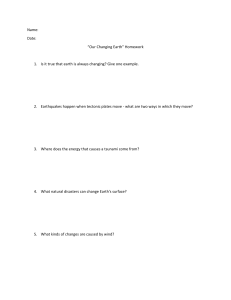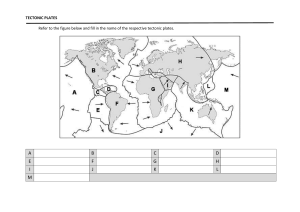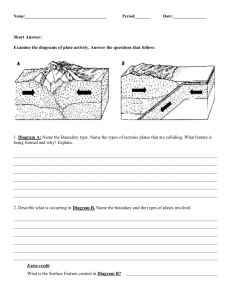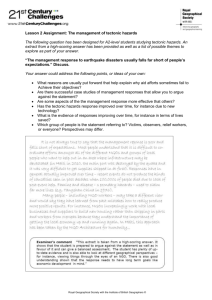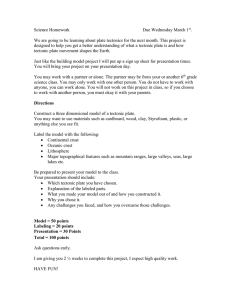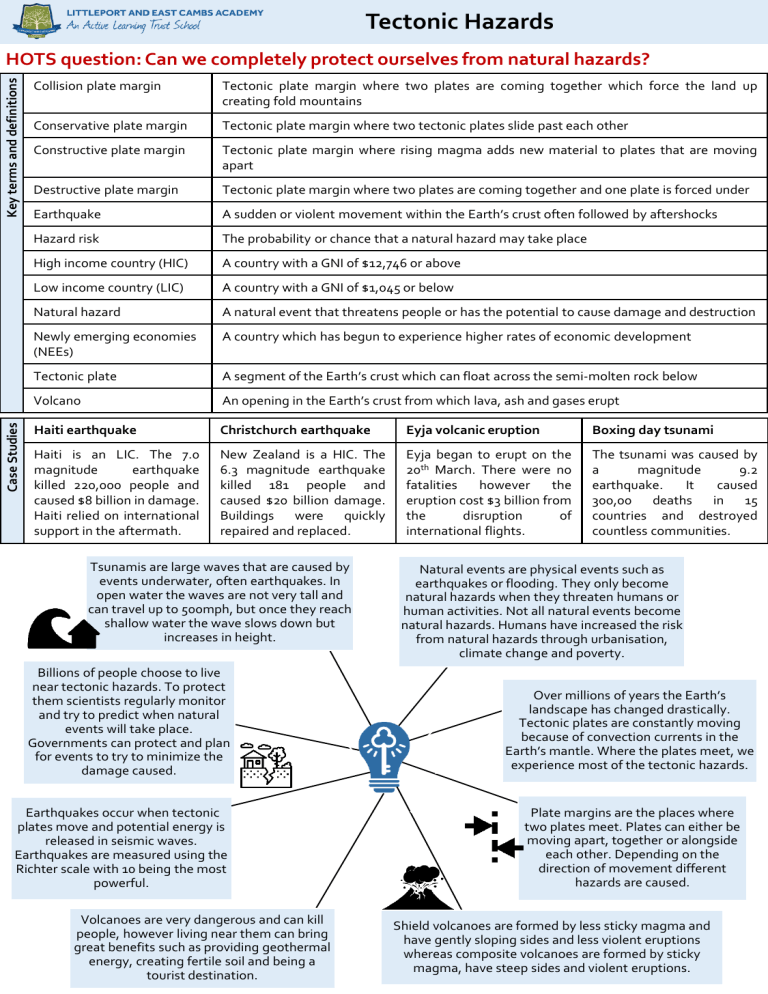
Tectonic Hazards Case Studies Key terms and definitions HOTS question: Can we completely protect ourselves from natural hazards? Collision plate margin Tectonic plate margin where two plates are coming together which force the land up creating fold mountains Conservative plate margin Tectonic plate margin where two tectonic plates slide past each other Constructive plate margin Tectonic plate margin where rising magma adds new material to plates that are moving apart Destructive plate margin Tectonic plate margin where two plates are coming together and one plate is forced under Earthquake A sudden or violent movement within the Earth’s crust often followed by aftershocks Hazard risk The probability or chance that a natural hazard may take place High income country (HIC) A country with a GNI of $12,746 or above Low income country (LIC) A country with a GNI of $1,045 or below Natural hazard A natural event that threatens people or has the potential to cause damage and destruction Newly emerging economies (NEEs) A country which has begun to experience higher rates of economic development Tectonic plate A segment of the Earth’s crust which can float across the semi-molten rock below Volcano An opening in the Earth’s crust from which lava, ash and gases erupt Haiti earthquake Christchurch earthquake Eyja volcanic eruption Boxing day tsunami Haiti is an LIC. The 7.0 magnitude earthquake killed 220,000 people and caused $8 billion in damage. Haiti relied on international support in the aftermath. New Zealand is a HIC. The 6.3 magnitude earthquake killed 181 people and caused $20 billion damage. Buildings were quickly repaired and replaced. Eyja began to erupt on the 20th March. There were no fatalities however the eruption cost $3 billion from the disruption of international flights. The tsunami was caused by a magnitude 9.2 earthquake. It caused 300,00 deaths in 15 countries and destroyed countless communities. Tsunamis are large waves that are caused by events underwater, often earthquakes. In open water the waves are not very tall and can travel up to 500mph, but once they reach shallow water the wave slows down but increases in height. Billions of people choose to live near tectonic hazards. To protect them scientists regularly monitor and try to predict when natural events will take place. Governments can protect and plan for events to try to minimize the damage caused. Earthquakes occur when tectonic plates move and potential energy is released in seismic waves. Earthquakes are measured using the Richter scale with 10 being the most powerful. Volcanoes are very dangerous and can kill people, however living near them can bring great benefits such as providing geothermal energy, creating fertile soil and being a tourist destination. Natural events are physical events such as earthquakes or flooding. They only become natural hazards when they threaten humans or human activities. Not all natural events become natural hazards. Humans have increased the risk from natural hazards through urbanisation, climate change and poverty. Over millions of years the Earth’s landscape has changed drastically. Tectonic plates are constantly moving because of convection currents in the Earth’s mantle. Where the plates meet, we experience most of the tectonic hazards. Plate margins are the places where two plates meet. Plates can either be moving apart, together or alongside each other. Depending on the direction of movement different hazards are caused. Shield volcanoes are formed by less sticky magma and have gently sloping sides and less violent eruptions whereas composite volcanoes are formed by sticky magma, have steep sides and violent eruptions.
